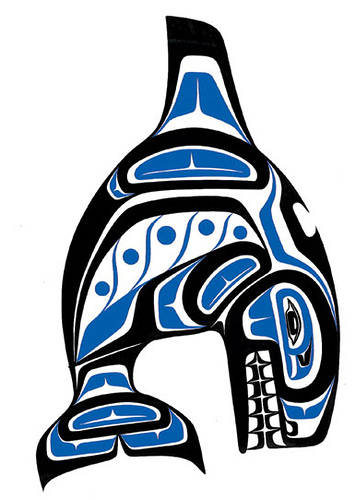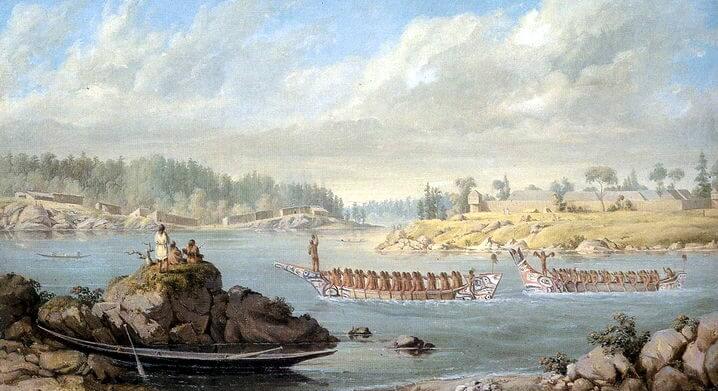Join a Kayak Quest for Whales Today!
According to the late anthropologist Wayne Suttles, the San Juan Islands were the traditional fishing, harvesting, and gathering place of several tribes belonging to the Coast Salish language group (pronounced SAY’-lish). For most of their history there was no single term to describe these people who share a common linguistic and cultural origin.
The term “Salish” is not from any of the native languages or cultures of the coastal region, and refers to the Selisch people of Montana and Idaho, who were the first group encountered speaking what has become called the Salishan language family. Eventually, language differences between the interior and coastal tribes led to the division into Coast Salish and Interior Salish.
The various Coast Salish tribes became established in southwestern British Columbia and northwestern Washington state over 8000 years ago. Prior to this, we know little of the native American groups who preceded the Coast Salish as far back as 12,000 years ago. These original inhabitants colonized a barren, windswept region recently freed from immense glaciers. They were a hardy folk, probably of the widespread Clovis culture, who faced a much different climate and ecosystem that included game animals such as bison and moose that no longer survive in the area.

The Coast Salish moved into Washington and British Columbia after the climate became warmer and wetter, around the time that the vast forests and river systems had matured. Their maritime culture’s advanced skills and technology gave them a competitive advantage over their predecessors. Their economy was based on rich marine resources such as salmon, herring roe, waterfowl and their eggs, clams and other shellfish, and kelp and other algaes. Coastal tribes also traded with the Interior Salish via trails over the Cascade mountain passes. Their ingenuity and the natural wealth of their territories allowed them a very high standard of living compared to other native North Americans, and afforded them the time to pursue arts and develop what was reputedly the most egalitarian society in the world.

Coast Salish were excellent mariners and traveled extensively through the region in canoes that ranged in size from solo craft up to massive multi-family vessels. They favored open canoes over sea kayaks for their ease of loading supplies and family members. They shared the waters with orca whales and were often inspired to embellish their craft with artistic representations of the orcas. Killer whales also featured prominently in totem poles and other art. Some believed that dead chiefs and drowning victims were reincarnated or transformed into orca whales.
The name Salish Sea, recently applied to the waters surrounding their homelands, is a modern invention as there was never a commonly shared name for any of the water bodies in any of the Coast Salish languages. But modern tribal leaders like the new designation, because as one chief says, “it identifies the Coast Salish ownership of the sea. The Salish Sea is an integral part of our culture, and our whole existence.” Another was quoted saying “The Salish Sea has provided travel ways for our ancestors and people for decades. It is part of our past, present and future.”
The San Juan Islands were used by the Coast Salish tribes mainly during the summer months and when large numbers of salmon were migrating. Many different tribes shared the bounty of the area during these harvests and used traditional summer encampments but maintained more permanent villages outside of the islands. These include the Saanich, Songish, and Sooke, whose main populations resided on nearby Vancouver Island. The Semiahmoo came from their permanent settlements on mainland British Columbia. Lummi, Swinomish, and Samish all had their strongholds on the mainland of Washington.
These tribes each spoke their own unique dialect but they were mutually intelligible and this is likely why they were able to peaceably share the San Juan Islands. When more distant tribes were encountered a sign language or pidgin vocabulary was used. Some visiting tribes, such as the Haida, came not to talk or trade but rather to steal goods and food, take local residents as slaves, and to kill for social status. The first military garrisons in the islands were established as a deterrent to these hostile northern tribes. Euro-American settlers encouraged the development of a widespread pidgin language for trading and negotiating marriages, treaties, etc. Most of the earliest pioneers owed their survival to the native wives they typically married.

In 1855, the Treaty of Point Elliott was signed to establish the reservation system. The Lummi believed the San Juan Islands to be their point of origin and knew Eastsound as Tsuhl-whee’k-seeng, a village with three longhouses, the largest of which was 200 by 60 feet. A least 10 other Lummi villages were occupied in the San Juans at the time, including P’kweekh-eel-wuhlh on San Juan Island, believed to be the original home of the Lummi and Songish through Sweh-tuhn, the first man.
Today, the Lummi, Samish, and Swinomish have fishing rights in the San Juan Islands, and all three maintain cultural and/or environmental resource programs on the islands. Lummi own Madrona Point on Orcas Island. Samish operate a salmon stream restoration program in the islands and have conducted archeological work on Lopez Island.
Bill James, retired coordinator of the Lummi language program at Northwest Indian College, once said, “(Our culture) is still alive. Our people do exist. We no longer physically occupy the islands, but our ancestry is there, the spirits of our ancestors are there. We relate to that area and the spirit of the place. People need to take the time to learn where the tribes and peoples are today and learn the real history of why we are where we are.” Sharon Kinley, director of the Coast Salish Institute at Northwest Indian College, added, “We still remember the old people. We still hold ceremonies and rituals that honor our old people.”
With such a long history of human habitation, it’s not surprising that human remains are found about once a year in the San Juan Islands. Remains are left where they are if found in an area not frequented by people. Burial and cultural sites are protected by state and federal law.